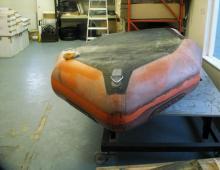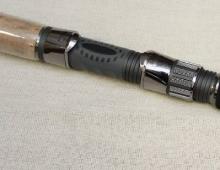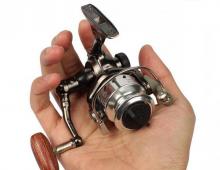Do-it-yourself feeder equipment and the process of fishing on the feeder
In the framework of this article, we will analyze how to make and set up feeder tackle and start fishing. The guide is large, so let's make a menu with a plan:
Feeder tackle set
Feeder rod, selection criteria
Before you start choosing a feeder rod, you need to decide on the place of future fishing. After all, your selection criteria will depend on this. The reason for this was the lack of universal feeders, which would allow fishing both in ponds and in fast-flowing rivers. It is necessary to buy your first feeder with special care, it is better if an experienced fisherman helps you with this.
There is a whole approach to the competent and correct selection of rods. If you are going to be fishing in a body of water with strong currents, or if you need to cast long distances, look for a long rod with a large test load. For example, medium-heavy, heavy and extra-heavy feeders.
If you want to catch carp, then choose light or medium-light rods.
Pricing policy for feeder rods is different. There are high-quality and inexpensive models, and there are professional ones that will be able to serve you faithfully for many years. Although it is not necessary to make a large investment in a feeder used several times a year, usually gathering dust somewhere in a closet. If you are an avid fisherman and thus constantly rest. And on weekends and on vacation you often find time to go fishing, then you need to choose a reliable feeder.
In the process of purchasing a feeder rod, carefully review each of its knees. Pay special attention to the smoothness of the inserts of the guide rings, the thickness of the blank and the comfort of the handle. If you see even the slightest defects, immediately replace the feeder with another one. When the external inspection ended normally, assemble the feeder and gently shake it in your hand.
Thus, you can determine the presence of knee play by hearing characteristic tapping. This rod doesn't suit us either. To make sure of the reliability and quality of the reel seat, you need to install the reel that you will constantly use in this feeder configuration. Displacement of the "meat grinder" in all directions should not occur in any case.
Coil (freewheel)

Price policy
Taking into account the fact that fishing with a feeder involves frequent casting of feeders, real battles with an active and strong predator in a pond with a large current, various snags and grass thickets in the process of choosing a reel, special attention should be paid to its reliability. And this is the quality of the material from which it was made, and the correct assembly. From which the cost of coils of a well-known brand is high. A good reel costs at least fifty dollars. But this does not mean that you have to go to extremes and immediately purchase a reel for two hundred dollars, especially if you are new to this business. Don't waste money. Get something in between, and then you yourself will understand what suits you best.
Gear ratio
This number indicates the number of revolutions made by the rotor during one rotation of the handle. At the same time, the gear ratio of 4: 1 indicates that the spool turned four times in one turn of the handle.
Experts distinguish between power and speed models. The first digit of the coil name indicates the speed. Models with universal characteristics include such coils, the gear ratio of which is 4.6 - 5.5. If it is more than 5.5 - the coil is high-speed, and less than 4.6 - power.
Spool dimensions and material
For the feeder method of fishing, experts recommend using spools with a size of 2,500-4,000. At the same time, a spare spool is required. It is better when the main spool is made of metal, and the auxiliary spool is made of graphite. In the first case, pay attention that there are no scratches and burrs. In the second, for fishing line, you can take graphite. If this is not included in the kit, you need to buy it separately.
Friction brake type
The friction clutch is designed to prevent the line from breaking during strong jerks. Its inclusion involves the impact on the spool, more precisely on the supply of the cord, to reduce the load to a normal limit.
Friction distinguish between rear and front. Here you should be guided solely by your wishes. The front type clutch is more sensitive to adjustment and makes a larger frictional force. Moreover, in this case, the coil will become lighter and more compact. Whereas the rear type clutch is the most practical and convenient in the process of playing fish. Replacing the spool in it is done faster than in the analogue.
Number of bearings
Thanks to the bearings, the stability and smooth operation of the entire structure of the reel seat increases. A spinning reel can have up to fifteen bearings. It is best suited for the feeder method of fishing.
Line selection
Braided or monofilament? what to use for the feeder?
To begin with, it is worth mentioning that both braided line and monofilament are used for the feeder fishing method. The main advantage of the braid is its supersensitivity. This is especially important not so much in the process of biting, but as at the moment of tapping the bottom of the reservoir. After all choosing the right fishing spot is an important part of successful fishing.
On the other hand, feeder line has a very attractive cost. And since fishing on a feeder involves fishing from cliffs, in places of eyebrows and snags, you often have to cut the line. Braid is more prone to this kind of damage. And it’s a pity to lose several meters of braid in an instant on the edge.
Regarding sensitivity, it is important to pay attention to what distances the casts will be. Taking into account the fact that the feeder method of fishing involves casting at 20-30 meters, the difference in sensitivity is imperceptible.
Since the line stretches best, the fisherman will have the opportunity to bring out a large trophy. After all, there will be amortization of jerks, which sometimes has a decisive word.
Especially feeder fishing line justifies itself on paid reservoirs in pursuit of carp.
Leash with hook
The choice of the size and shape of the hook is made taking into account the conditions of fishing. The invisibility of the equipment will depend on how passive the bite is, and the fish behaves more meticulously. Therefore, the leash is placed thinner, and the hook is smaller. Although reducing the hook carries with it the possibility of losing your trophy.
Bite alarm
Bells were previously considered the most popular type of signaling devices. Although this created such a noise that the fishermen nearby looked at their negligent neighbor for a long time. Technological progress has also reached fishing, and electronic models of signaling devices have appeared that allow you to instantly respond to a bite. They came out on top among the new generation of efficient and practical signaling devices.
Rod stand
The most popular type of rod stand is the tripod, which is easily adjustable in height and angle. The tripod can additionally be equipped with a telescopic stand. A universal thread provides the ability to use various nozzles.
Types of feeder equipment
Which feeder equipment is more profitable in which case? Next, we will review each of the snap-ins and answer this question.
Paternoster

Such feeder equipment is created on the basis of a piece of monofilament or fluorocarbon fishing line, preferably with a diameter in the range of 0.28-035 mm. This partnership is based on two leads, with a leash attached to the long one and a feeder to the short one. It is necessary to adhere to such an unspoken rule: the length of the lead under the leash is recommended to be greater than the total length of the coil and the lead.
The installation of such a feeder equipment allows the use of lines of different diameters, and a thicker line is used to attach the leash. If, however, there is a situation that in the process of playing the fish, the feeder caught among the snags, you will have the opportunity to save the trophy, losing only it.
Video with a demonstration of knitting feeder rigs
The video clearly and clearly shows how to make a feeder equipment with your own hands.
Asymmetrical loop

An asymmetric loop involves an increase in the length of one of the arms to obtain supersensitivity. The difference in the length of the shoulders is provided by the so-called “overhang” for the feeder, the length of which is in the range of 0.5-3 cm. While the length of the loop itself is 15-50 cm.
These measurements are directly dependent on the conditions of use of the equipment, the activity of the fish and the fishing tactics used.
This loop is made on the basis of a monofilament or fluorocarbon fishing line with a diameter of 0.28-0.35 mm.
In this case, it is worth considering the fact that the length of the outlet is recommended to be greater than the total length of the "overhang" and the feeder. This method of assembling feeder equipment is recommended for use in reservoirs with strong currents.
Also have equipment "symmetrical loop" and it differs only in that the loops are not of different lengths, but of one.
Helicopter

Such a feeder installation involves the free rotation of the leash around the main line, resembling the blades of a helicopter. "Helicopter" is best used for catching active fish in reservoirs with a strong current. After all, only in this case the leash with the bait will rise above the bottom. Consequently, the trophy fishing horizon is expanding, allowing you to catch fish at an impressive distance from the surface of the bottom of the reservoir.
By adjusting the length and diameter of the leash, as well as the dimensions of the hooks, the effect of simulating the slow lowering of the bait is achieved. Therefore, the activity of the bite increases.
Tool with anti-twist

This is the simplest method of assembling a feeder rig. Its implementation involves the following manipulations:
- Thread the line into the hole of the anti-twist, which is presented in the form of a plastic tube, directly on the pond.
- As a stopper on the main fishing line, put on a bead made of rubber or plastic.
- Attach the leash to the line.
- Fasten the tubing to the carabiner - the anti-twist feeder.
Since in this case no special skills are needed to assemble the feeder and the likelihood of entanglement is practically eliminated, this method is popular. Although it is also characterized by a low level of sensitivity of the equipment, its bulkiness and visibility in the water column. It happens when the tube becomes clogged with dirt, the sensitivity completely disappears.
harvester

Such feeder equipment is based on an anti-twist tube. Except that in this case it is necessary to attach a fishing line to the swivel in the form of a loop measuring 10 cm. And only then can you proceed with the installation of the feeder itself. Most often, this type of equipment is made at home using short and long loops. Then, through the entire tube, it is necessary to stretch the fishing line, locking it with a small cambric.
Inline

It is not difficult to perform such equipment, but be sure to consider:
- the presence of a twist with a length of 10-15 cm is necessary, which exceeds the length of the feeder;
- if fishing is supposed to be in places with bottom silt, then the installation of the feeder is carried out exclusively on the branch, and the length of the twist should increase.
The principle of operation of this kind of equipment is elementary.
- The main fishing line, called the shock leader, is pulled into the feeder's swivel hole.
- A bead made of rubber or plastic acts as a stopper.
- Behind the stopper, a loop is made for fastening with a leash.
This type of feeder equipment is characterized by the free movement of the feeder along the main line. Therefore, it is often referred to as "sliding montage".
If you decide to use plastic beads, then it is recommended to put on a rubber cambric or a silicone stopper between the termination and the loop for fastening with a leash, which will prevent damage to the knot at the base of the loop.
Such an assembly is the only permitted option in the process of an international type competition for fishing with a feeder. This is because it is possible for the feeder to come off the line freely at the moment the gear breaks.
Feeder fishing technique
Place feeding
Before you start fishing with feeder equipment, you need to properly feed the place. To do this, it is recommended to make 10-20 casts of fully stuffed feeders. Having made the first cast, it is worth making sure that the rest will be performed in the same place. After waiting for the moment when the feeder touches the surface of the water, you can put the rod in the position of waiting for a bite.
After lowering the feeder to the bottom, the rod will significantly loosen its line tension. At the same time, it is recommended to cut it well and pull it out again for further feeding.
playing
As soon as you feel a bite, immediately pull your trophy. Most often, thus, the fish self-cuts. Of course, you can take your time, but this is only in the case when there is no possibility of her leaving for snags or grassy thickets.
Fishing with feeder equipment is interesting and exciting when there is a good bite and there is a chance to get a big catch!
Read more detailed and detailed material on fishing on a feeder.



